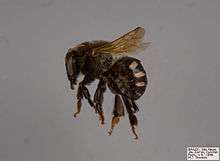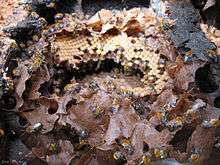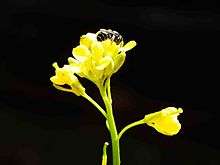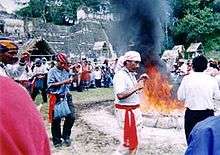Melipona beecheii
| Melipona beecheii | |
|---|---|
 | |
| Female Melipona | |
| Scientific classification | |
| Kingdom: | Animalia |
| Phylum: | Arthropoda |
| Class: | Insecta |
| Order: | Hymenoptera |
| Family: | Apidae |
| Subfamily: | Meliponini |
| Genus: | Melipona |
| Species: | M. beecheii |
| Binomial name | |
| Melipona beecheii Bennett, 1831 | |
 | |
| Range of M. beecheii[1] | |
Melipona beecheii is a species of eusocial, stingless bees of the order Hymenoptera and the genus Melipona. It is native to Central America from the Yucatán Peninsula in the north to Costa Rica in the south.[2] M. beecheii was cultivated in the Yucatán Peninsula starting in the pre-Columbian era by the ancient Maya civilization. The Mayan name for M. beecheii is "xunan kab," which translates roughly to "regal lady bee."[3] M. beecheii once served as the subject of various Mayan religious ceremonies.
Taxonomy and phylogeny
Melipona beecheii is a member of the family Apidae of eusocial bees within the order Hymenoptera. The subfamily Meliponini is commonly referred to as "stingless bees." The genus Melipona contains nearly 50 other species.[4]
Description and identification
.jpg)
Melipona beecheii has a golden-yellowish and brown striped body with translucent wings attached to the back. It has a rounded body composed of a head, thorax, and abdomen, none of which are segmented, but rather are separated more subtly. Antennae protrude from the head and stick straight out. M. beecheii has small, white hairs covering the head, thorax, and abdomen.[5]
Queens, workers, and drones are all roughly the same size. Moreover, all members of the hive regardless of their future role develop in identical, mass-provisioned, sealed cells. This allows for self-determination of roles, the root of caste conflict within M. beecheii.[6]
Distribution and habitat

Melipona beecheii is a tropical eusocial bee that has been observed in a variety of geographic locations with tropical climates.[1] M. beecheii can be found in Central America, especially in the southern Yucatán Peninsula of Mexico, Guatemala, El Salvador, Nicaragua, and Costa Rica.[7]
Conservation status
Melipona beecheii has been observed primarily in tropical forests, both humid and arid.[5] M. beecheii builds its nests inside hollow cavities of trees and, as a result, has been seriously affected by deforestation.[8] Moreover, there is increasing use of insecticides in the forest and decreasing interest in the ancient Mayan practice of beekeeping. Beekeepers who work with M. beecheii in the Mayan zone in Quintana Roo state, Mexico, have reported a 93% decrease in hives over the past twenty-five years.[1]
Colony cycle
In M. beecheii, all females, even those designated to be workers, have the ability to develop as queens. As a result of this potential to self-determine, immature females may try to develop as queens in order to gain greater reproductive opportunities. When a colony's queen dies, or before the formation of new colonies by swarming, new queens are produced, only one of which is selected to serve in that function per colony. Workers kill the extra queens by biting off their heads, abdomens, and limbs. The average life expectancy of developing queens is 47 hours.[6]
Advantages to producing excess queens include the provision of spare queens in case of queen failure, and the ability to select the best queen from a pool of candidates.[6]
Behavior
Division of labor
Melipona beecheii exhibits foraging specialization within the community. Single-foraging bees are responsible for harvesting one single commodity, such as pollen, nectar, or resin, in a single day while multi-foraging bees will forage for two or three of those resources. About half of the bees are single-foraging and half are multi-foraging. A switch in foraging specialization occurs very rapidly, often within a single day.
It was found that no one style was advantageous over the other in terms of feeding and resource acquisition opportunities. However, activity patterns and longevity differed significantly between groups. Individuals responsible for foraging nectar were observed to be active all day and died, on average, after three full days of foraging. On the other hand, pollen foragers were only observed to be active for about 1–3 hours per day and lived for an average of 12 days. In spite of this contrast, it was found that both styles of foraging resulted in an equal amount of flights in a lifetime. The way in which individual M. beecheii organisms' foraging style is designated within the community is still unknown.[9]
Caste determination
Caste determination in Hymenoptera is either trophogenic or genetic. In trophogenic caste determination, an organism's caste is dictated by the quality and quantity of food it received during development. In genetic caste determination, an organism's caste is inherent in its genetics. Trophogenic caste determination is much more common; genetic caste determination is quite rare. While there is some evidence for a nutritional influence on caste determination in Melipona, in M. beecheii queens and workers have similar weights, supporting self-determination of caste.[6]
Reproduction
Similar to most beehives, an M. beecheii colony has one fertile queen and numerous nonreproductive female worker bees. The queen that is fertile and lays eggs is known as the physogastric queen. However, in M. beecheii excess queens are produced, most of which are destined to remain virgins. These excess queens are almost always killed by workers before they are able to lay eggs.[10]
Pre-discharge phase
The physogastric queen’s reproduction is dependent on the workers. The workers arrange the cells prior to the queen's arrival.[11] When the queen arrives at a cell, the pre-discharge phase begins with a worker inserting themselves into a cell.[11]
Discharge phase
The queen then performs oviposition, the process of depositing eggs into a cell. The queen taps the worker with her antennae and forelegs. This contact serves to signal the worker to insert larval food into the cell.
Afterwards, the queen checks the cell and eats the trophic egg, an unfertilized egg that is made specifically for the queen’s nutrition.[11]
Abiotic factors
Melipona beecheii reproduction depends on many abiotic factors, including the time of year, climate, and resources available. Extreme reproduction was observed at the end of the rainy season wherein an excess of resources were able to be stored. In contrast, due to poor resource obtainment, M. beecheii populations decreased when there were good foraging conditions and food storage had built up.[11] When foraging conditions are good, less energy is expended on reproduction.
Interaction with other species
Diet

Melipona beecheii, like most other bee species, consumes nectar and pollen. M. beecheii exhibits foraging specialization within the community.[9]
Predators
The typical predators of M. beecheii are many different species of birds, spiders, lizards, and other bugs. M. beecheii is an easier target because it is unable to sting as a form of defense.[9]
Given that the genus Philanthus is a carnivorous genus of wasps, different species from the genus, most notably Philanthus gibbosus, have been observed to prey on M. beecheii. The M. beecheii prey that is captured by P. gibbosus gets coated in a thick layer of pollen before being fed to developing larvae. Eggs are laid in the pollen-coated wasp and the pollen-coated bee wasp is consumed by the developing larvae. The coat of pollen serves as an additional source of protein for the young wasps.[12]
Parasites
Melipona beecheii is parasitized primarily by the parasitic phorid fly, Pseudohypocera kerteszi. Other than this organism, there are not many parasites or disease-causing organisms that affect M. beecheii. In general, American foulbrood, which is caused by Paenibacillus larvae, is a harmful disease for all honey-producing bees, but there is not much data regarding its specific effect on M. beecheii.[13]
Mutualism
Melipona beecheii often has mutualisms with flowering plants. M. beecheii pollinates the flowers by carrying both nectar and pollen between plants, allowing them to collect food for themselves and their colony in the process. While it is not yet clear which specific flowering plants M. beecheii forms mutualistic relationships with, the patterns and habits have been studied so a mutualistic relationship has been confirmed.[9]
Competitors
Melipona beecheii's main competitors are other pollinating insects. For M. beecheii in its tropical environment, its other pollinating, stingless bee competitors include Melipona fasciata and other nests of M. beecheii.[14]
Defense
Though M. beecheii is a stingless bee, it has the ability to bite other organisms when it feels threatened or is under attack. When in a communal setting, M. beecheii coordinates attack signals via secretions from their mandibular glands. The main pheromone involved in eliciting a communal attack response in M. beecheii is farnesyl acetate. When secreted, all individuals in the nest are stimulated to attack.[15]
An additional strategy that M. beecheii uses to protect itself from predation is remaining inside its nest. Because M. beecheii primarily builds its nest inside trees, remaining inside the nest proves to be a rather sturdy and safe environment to protect each individual organism from predation.[15]
Human importance
Beekeepers in the Yucatán peninsula have harvested honey from the nests of M. beecheii until African honeybees arrived. As a result, M. beecheii is facing loss of habitat and the ancient tradition of stingless beekeeping is on the verge of dying out.[1]
Agriculture
.jpg)
Because M. beecheii is a stingless bee and eats nectar, its ecological niche does not involve hunting pest insects. However, M. beecheii plays an extremely important role in honey production, as they have been kept for centuries almost exclusively in log nests primarily by people who live in the Yucatán Peninsula of Mexico. M. beecheii is an important source of honey both in the region and around the world. Due to the concern that stingless bee keeping is going extinct, the possibility of negative effects resulting from the impact of competition from feral African Apis mellifera, over-harvesting, failure to transfer colonies to hives or divide them, deforestation, hurricane damage and lack of instruction and incentive for new stingless bee keepers has been postulated and explored.[1]
Stings
Melipona beecheii is a stingless bee and, as a result, cannot sting humans or other organisms. This characteristic makes them ideal for beekeeping. That being said, when agitated, M. beecheii does have the capacity to bite other organisms. However, there is no medical hazard or allergy factor involved.[1]

History and art
In accordance with Mayan history, M. beecheii are the embodiment of a link to the spirit world, an endowment of the god Ah Muzen Cab.[16] M. beecheii once served as the subject of various Mayan religious ceremonies.[1] M. beecheii has been greatly revered by Mayan culture throughout history, leading to its keeping by the Mayan people as a means of attaining a higher-being, one which is closer to God. According to the Maya tradition, a priest would harvest M. beecheii honey during a religious ceremony that would take place twice a year. As a means of increasing the number of nests and honey production, beekeepers would regularly divide existing nests. This would also help to alleviate the predicament of excess queens that occurs with M. beecheii.[1]
References
- 1 2 3 4 5 6 7 8 Villanueva, Rogel et. al (2005). "Extinction of Melipona beecheii and traditional beekeeping in the Yucatán peninsula". Bee World. 86 (2): 35–41. doi:10.1080/0005772X.2005.11099651.
- ↑ de Jesús May-Itzá, Jesús et. al (2009). "Intraspecific variation in the stingless bee Melipona beecheii assessed with PCR-RFLP of the ITS1 ribosomal DNA". Apidologie. 40 (5): 549–555. doi:10.1051/apido/2009036.
- ↑ "Diccionario Introductorio" (PDF). uqroo.mx (in Spanish). Universidad De Quintana Roo. Retrieved 21 September 2015.
- ↑ Ramírez, Santiago R. et. al (2010). "A molecular phylogeny of the stingless bee genus Melipona (Hymenoptera: Apidae)". Molecular Phylogenetics and Evolution. 56: 519–525. doi:10.1016/j.ympev.2010.04.026.
- 1 2 Biesmeijer, Jacobus C. et. al (1999). "Niche differentiation in nectar-collecting stingless bees: the influence of morphology, floral choice and interference competition". Ecological Entomology. 24 (4): 380–388. doi:10.1046/j.1365-2311.1999.00220.x.
- 1 2 3 4 Weenslers, Tom et. al (2004). "Queen Execution and Caste Conflict in the Stingless Bee Melipona beecheii". Ethology. 110: 725–736. doi:10.1111/j.1439-0310.2004.01008.x. ISSN 0179-1613.
- ↑ Francoy, Thiago M. et. al (2011). "Geometric morphometrics of the wing as a tool for assigning genetic lineages and geographic origin to Melipona beecheii (Hymenoptera: Meliponini)". Apidologie. 42 (4): 499–507. doi:10.1007/s13592-011-0013-0.
- ↑ Sommeijer, Marinus J. (1999). "Beekeeping with stingless bees: a new type of hive". 80 (2): 70–79. doi:10.1080/0005772X.1999.11099429.
- 1 2 3 4 Biesmeijer, J.C. (1998). "Individual foraging, activity level and longevity in the stingless bee Melipona beecheii in Costa Rica (Hymenoptera, Apidae, Meliponinae)". 45: 427–443. doi:10.1080/0005772X.1999.11099429.
- ↑ Jarau, Stefan (2010). "A scientific note on virgin queen acceptance in stingless bees: evidence for the importance of queen aggression*". 41. doi:10.1051/apido/2009045.
- 1 2 3 4 Van Veen, J.W. (1999). "Nest and colony characteristics of log-hived Melipona beecheii (Apidae: Meliponinae)". 38 (1–2): 43–48. doi:10.1080/00218839.1999.11100994.
- ↑ Polidori, Carlo; Crottini, Angelica; Venezia, Lidia Della; Selfa, Jesús; Saino, Nicola; Rubolini, Diego (2013-06-28). "Food load manipulation ability shapes flight morphology in females of central-place foraging Hymenoptera". Frontiers in Zoology. 10 (1): 36. doi:10.1186/1742-9994-10-36. ISSN 1742-9994. PMC 3698194
 . PMID 23805850.
. PMID 23805850. - ↑ Medina, L.M. et. al (2009). "Hygienic behavior in the stingless bees Melipona beecheii and Scaptotrigona pectoralis (Hymenoptera: Meliponini)". 8 (2): 571–576.
- ↑ de Bruijn, L.L.M. et. al (2005). "MANDIBULAR GLAND SECRETION OF Melipona beecheii:CHEMISTRY AND BEHAVIOR". 31: 1621–1632.
- 1 2 Cruz-López, Leopoldo et. al (2009). "Hygienic behavior in the stingless bees Melipona beecheii and Scaptotrigona pectoralis (Hymenoptera: Meliponini)". 8 (2): 571–576.
- ↑ Villanueva-G, Rogel; Roubik, David W.; Colli-Ucán, Wilberto (2005-01-01). "Extinction of Melipona beecheii and traditional beekeeping in the Yucatán peninsula". Bee World. 86 (2): 35–41. doi:10.1080/0005772X.2005.11099651. ISSN 0005-772X.